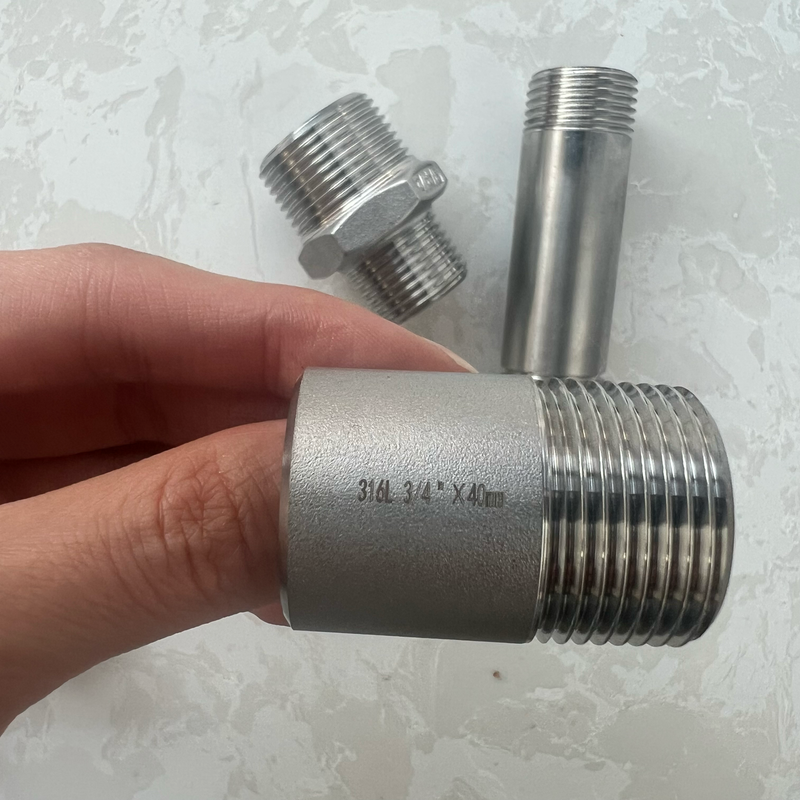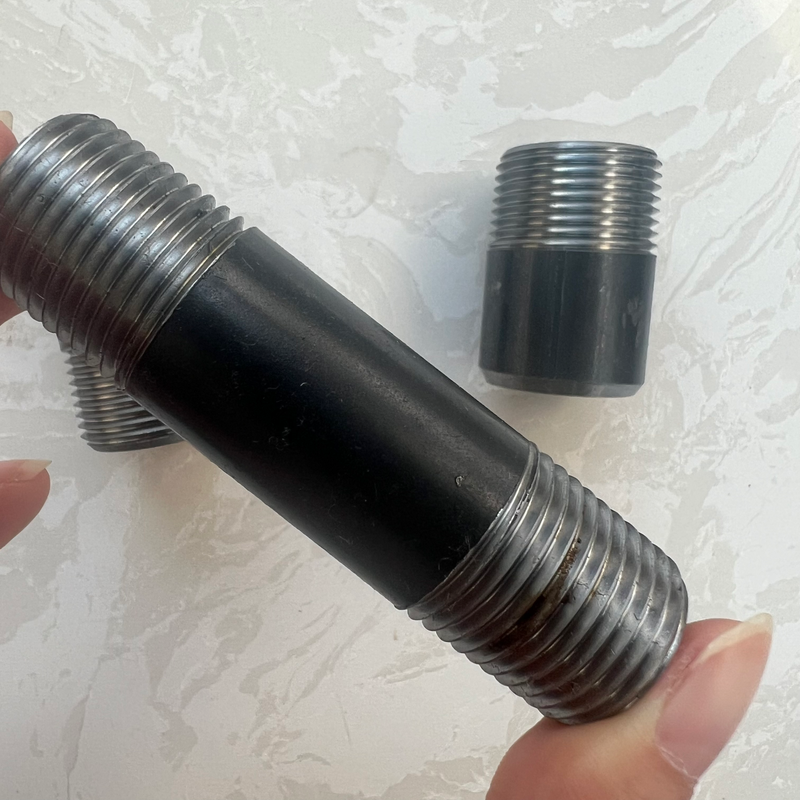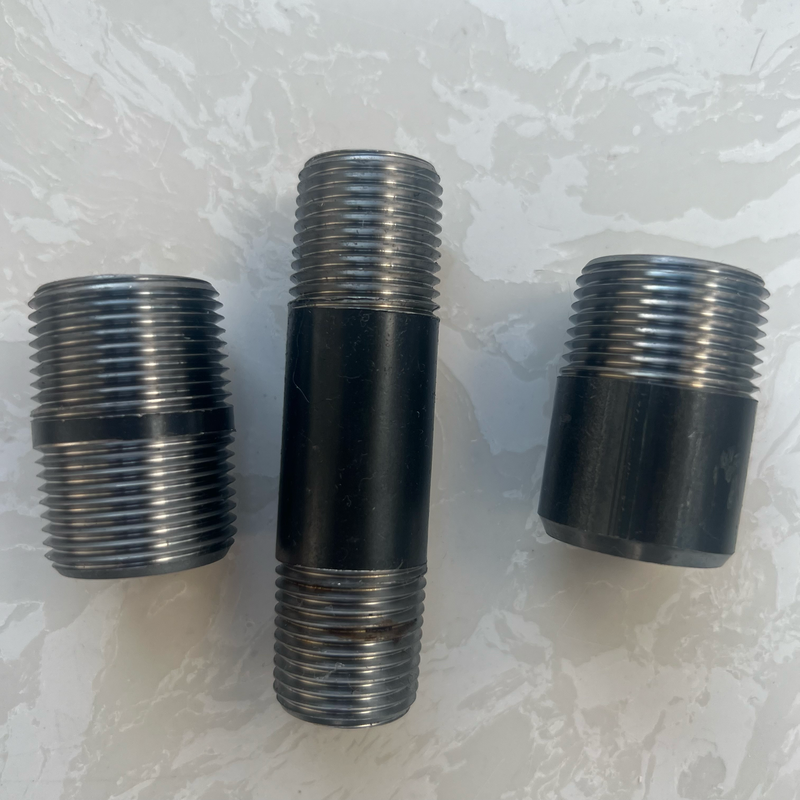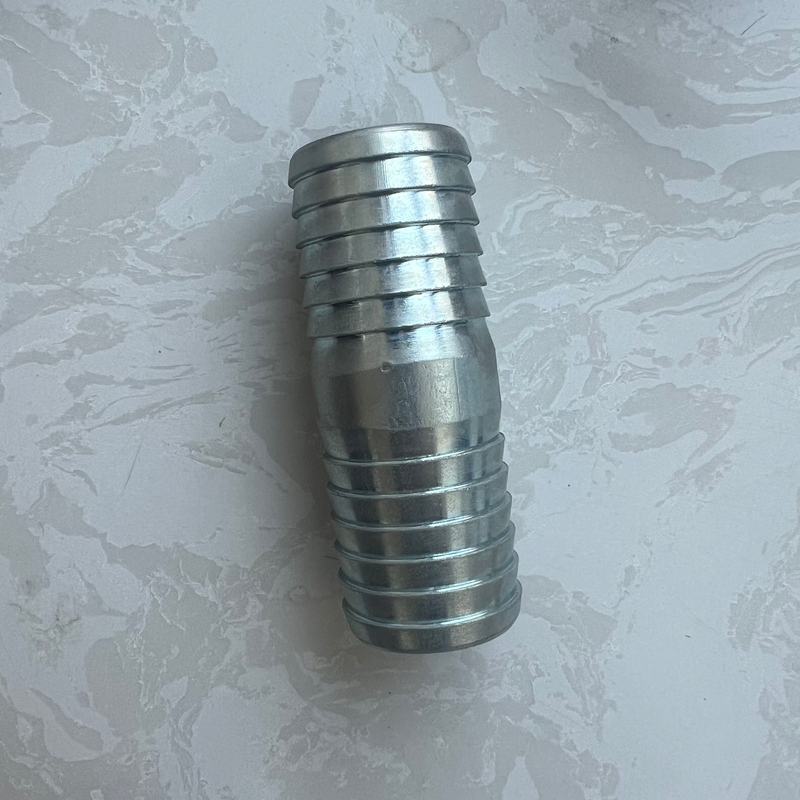1. Introduction
Pipe nipples are small but vital components in piping systems to connect, extend, or adapt pipelines and fittings. Pipe nipples whose versatility and functionality make them indispensable in industries ranging from construction and manufacturing to chemical processing and plumbing.
This text classification of pipe nipples is based on material, design, and application, emphasizing the distinct properties and benefits. Understanding these distinctions, select the ideal pipe nipples for your specific project requirements, ensuring the most performance, durability, and cost-efficiency.
2. Classify by Nipple Material
-
Stainless Steel Pipe Nipple
 The stainless steel nipple which material is 304 or 316 stainless steel.
The stainless steel nipple which material is 304 or 316 stainless steel.
High corrosion resistance, withstand harsh environments.
Stainless steel nipple has high strength, oxidation resistance, and long service life.
Smooth surfaces and excellent hygienic performance make it can be in the food and medicine industry.
-
Carbon Steel Pipe Nipple
Made of ASTM A106 or ASTM A53 carbon steel.
High strength and can withstand high-pressure application.
A lower price is more suitable for that low-budget project.
Carbon steel nipples can be with welding or mechanical connection and flexible installation.
But they are easier to rust, and anti-corrosion is poor.
Note:
Two types of carbon steel nipples usually include black and galvanized nipples. We will introduce them in more detail in the following. You can click the blue font and directly skip to the relevant description.
A galvanized nipple is a cast iron or carbon steel pipe after the surface is hot-dipped.
A galvanized nipple is more anti-rust than a general carbon steel nipple.
Economical price, cost-effective.
Galvanized steel nipple service life is longer than general carbon steel and more suitable for outdoor applications.


Black steel nipple covers a black oxide surface, which offers short-term protection to prevent rust when transporting and storing.
Lower cost.
Suitable for high-pressure pipeline applications, black pipe nipples can withstand big-gish mechanical stress.
Black steel pipe nipples can be welded, thread-processed, and cut easily.
Black nipples in moisture, acid, alkali, or salt application over a long time may increase the possibility of rust.


-
Compared Summary
| Material | Corrosion resistance | Pressure resistance | Cost |
| Stainless steel | High | High | Relatively high |
| Galvanized steel | Medium | Medium | Relatively low |
| Black carbon steel | Low | High | Low |
3. Classification by design
-
 Close Nipple
Close Nipple
The closed nipple threaded connection part is longer, and the middle unthreaded part is shorter and more suitable for compact pipe connection.
The close nipple installs effortlessly.
-
Long Nipple
Longer pipe, offer extra pipeline length, and reduce the used quantity of fittings.
-
 Hose Nipple
Hose Nipple
The hose nipple is a flexible pipe usually made of brass, stainless steel, and carbon steel. Hose nipple fittings are compatible with all tube materials and sizes, are installed easily, and withstand pressure and temperature variation. Please note that improper installation may increase leakage risk lately.
-
King Nipple
 A king nipple is usually longer than a hose nipple. Withstand industrial use for heavy-duty applications and high-pressure systems due to heavy-duty construction, and the design prevents tube slippage. King nipples ensure precise installation to avoid leaks. Galvanized steel king nipple may rust in extreme environments.
A king nipple is usually longer than a hose nipple. Withstand industrial use for heavy-duty applications and high-pressure systems due to heavy-duty construction, and the design prevents tube slippage. King nipples ensure precise installation to avoid leaks. Galvanized steel king nipple may rust in extreme environments.
-
Reducer Nipple
Reducing nipples have different diameters on the two ends, usually connected to varisized pipelines or fittings.
Reducer nipples solve the connection problems between different pipe specifications.
-
 Welded Nipple
Welded Nipple
The welded nipple typically features one non-threaded section, which requires welding during installation to ensure a secure seal.
Welded nipples have strong anti-pressure properties, making them suitable for high-pressure and high-temperature environments.
-
Hex Nipple

With the hex design in the middle part, you can easily install and move with a wrench and other tools. Hex nipples have two common types: one type has the same diameter at both ends for connecting to pipes or threaded pipe fittings, and another one which one end connects to a pipe or threaded pipe fitting, and the other connects to a hose pipe.
-
Compared Summary
| Type | Features | Advantages |
| Close Nipple | Shorter | Tight connection |
| Long Nipple | Longer, extended pipe | Reduce the use of pipe fittings |
| Hose Nipple | Barbed end, threaded connection | Easy installation, cost-effective |
| King Nipple | Thick walls, durable construction | Handles high-pressure, long-lasting |
| Reducer Nipple | Different diameters at both ends | Connect pipes of different specifications |
| Welded Nipple | One-end threadless design | Good sealing, high-pressure resistance |
| Hex Nipple | Middle hexagonal design | Easy to install and disassemble |
4. Conclusion
The pipe nipple is a crucial component in the piping system that can connect and extend various types and sizes of pipes and fittings. Steel pipe nipples have a lot of different product types according to material, design, and application to select the most suitable one to meet special needs.
Stainless steel fittings are ideal for high-corrosion environments. Carbon steel and galvanized steel are the most popular in outdoor applications.
Understand the characteristics, advantages, and limits of every nipple pipe fitting, and ensure you can purchase the best one for your project from us.





